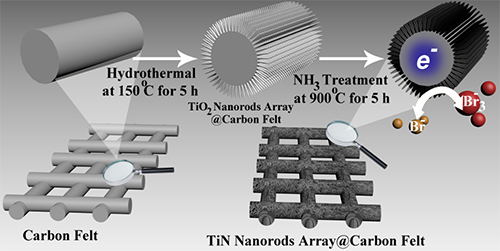A research group led by Prof. LI Xianfeng and Prof. ZHANG Huamin in the Dalian Institute of Chemical Physics (DICP) of the Chinese Academy of Sciences (CAS) designed and prepared a self-supporting three-dimensional (3D) hierarchical composite electrode based on TiN nanorods array to improve the activity of Br2/Br- redox couple and further power density of bromine-based flow battery. This work was published in Advanced Materials.

Schematic illustration of the fabrication of carbon felt supported TiN nanorods array 3D hierarchical composite electrode. (Image by WANG Chenhui)
Bromine-based flow batteries, especially zinc-bromine flow battery, own attracting features of high energy density and low cost and become a research hotspot in energy storage field. However, the activity of Br2/Br- redox couple is relatively low, causing relatively high electrode polarization and low power density of batteries. The cost of battery stacks is thus comparably high.
Therefore, the scientists proposed and prepared a self-supporting 3D hierarchical composite electrode based on TiN nanorods array to improve the activity of Br2/Br- redox couple.
In this design, the carbon felt severed as the supported matrix of the composite electrode to provide a 3D electron conductive framework, guaranteeing the high electronic conductivity. At the same time, the catalytic activity of TiN nanorods to Br2/Br- electrochemical reaction contributed to the reduced electrochemical polarization.
Moreover, the 3D micro-nano hierarchical and nanorods array alignment structure were in favor of the high electrolyte penetration and ion transfer rate to reduce the diffusion polarization. Accordingly, a zinc-bromine flow battery assembled with the designed composite electrode could operate at a current density as high as 160 mA/cm2, which was the highest current density ever reported.
This work exhibits a promising strategy to fabricate electrode for ultrahigh power density bromine-based flow batteries and largely accelerates the development and commercialize of bromine-based flow batteries.
This work waws supported by CAS STS program, CAS-DOE collaborative Project, Dalian science and technology innovation project and DICP funding. (Text by LU Wenjing)